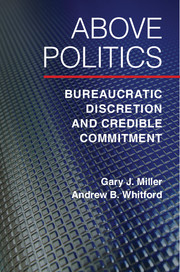Book contents
- Frontmatter
- Contents
- Preface
- Acknowledgments
- 1 Introduction
- 2 The Moral Hazard of Bureaucrats and Politicians
- 3 Political Moral Hazard and Credible Commitment
- 4 Political Moral Hazard and Bureaucratic Autonomy
- 5 “Above Politics”: The Separation of Powers and Bureaucratic Autonomy
- 6 The Control Paradox, Trust, and Leadership
- 7 Professionalism and Credible Commitment
- 8 The Politicization of Financial Regulation
- 9 The Financial Crisis and Reregulation
- 10 Conclusion: The Unraveling of Dodd-Frank
- Works Cited
- Index
- Other books in the series (Series List Continued from page ii)
6 - The Control Paradox, Trust, and Leadership
Published online by Cambridge University Press: 05 May 2016
- Frontmatter
- Contents
- Preface
- Acknowledgments
- 1 Introduction
- 2 The Moral Hazard of Bureaucrats and Politicians
- 3 Political Moral Hazard and Credible Commitment
- 4 Political Moral Hazard and Bureaucratic Autonomy
- 5 “Above Politics”: The Separation of Powers and Bureaucratic Autonomy
- 6 The Control Paradox, Trust, and Leadership
- 7 Professionalism and Credible Commitment
- 8 The Politicization of Financial Regulation
- 9 The Financial Crisis and Reregulation
- 10 Conclusion: The Unraveling of Dodd-Frank
- Works Cited
- Index
- Other books in the series (Series List Continued from page ii)
Summary
Any fool can make a rule. And every fool will mind it.
– Henry David Thoreau (Thoreau and Shepard, 1927, 327)RULES FOR FOOLS
On July 10, 2014, the U.S. House Committee on Financial Services held hearings on H.R. 5018, the Federal Reserve Accountability and Transparency Act of 2014, a bill sponsored by Representative Bill Huizenga (R-MI)
to amend the Federal Reserve Act to establish requirements for policy rules and blackout periods of the Federal Open Market Committee, to establish requirements for certain activities of the Board of Governors of the Federal Reserve System, and for other purposes.
Dr. John B. Taylor, noted Stanford economist, was the first witness – and for good reason. Taylor was famous for his advocacy of the so-called Taylor rule, which holds that central banks should tune the nominal interest rate according to a reaction function (a rule expressed as an equation) that depends on important economic conditions such as inflation. In a series of papers starting in 1993, Taylor had argued that a policy rule could be devised that allowed the federal funds rate to move as inflation increased above its target or real GDP increased above its trend. He noted, “Although there is not consensus about the size of the coefficients of policy rules, it is useful to see what a representative policy rule might look like” (J. B. Taylor, 1993, 202). He went on to show that a simple rule was a nice approximation of actual policy performance.
Since then, economists have done more than treat this rule as an academic exercise, writing hundreds of papers that have sought to elaborate what should go into such a rule, the coefficients or weights for those items, the general value of such a rule, and other important matters. Of course, some economists viewed divining such a descriptive model of the Fed's actions as a way to predict its actions in the future, and so to take market positions that account for that foresight. But for many, taking market positions was not the end-all of the research agenda Taylor started when he tried to describe this “representative rule.” For a number of academic economists and many political interests, the goal was a normative model of Fed behavior – a policy rule that would determine the actions the Fed should take (given the data) that would optimize national economic performance.
- Type
- Chapter
- Information
- Above PoliticsBureaucratic Discretion and Credible Commitment, pp. 120 - 140Publisher: Cambridge University PressPrint publication year: 2016



